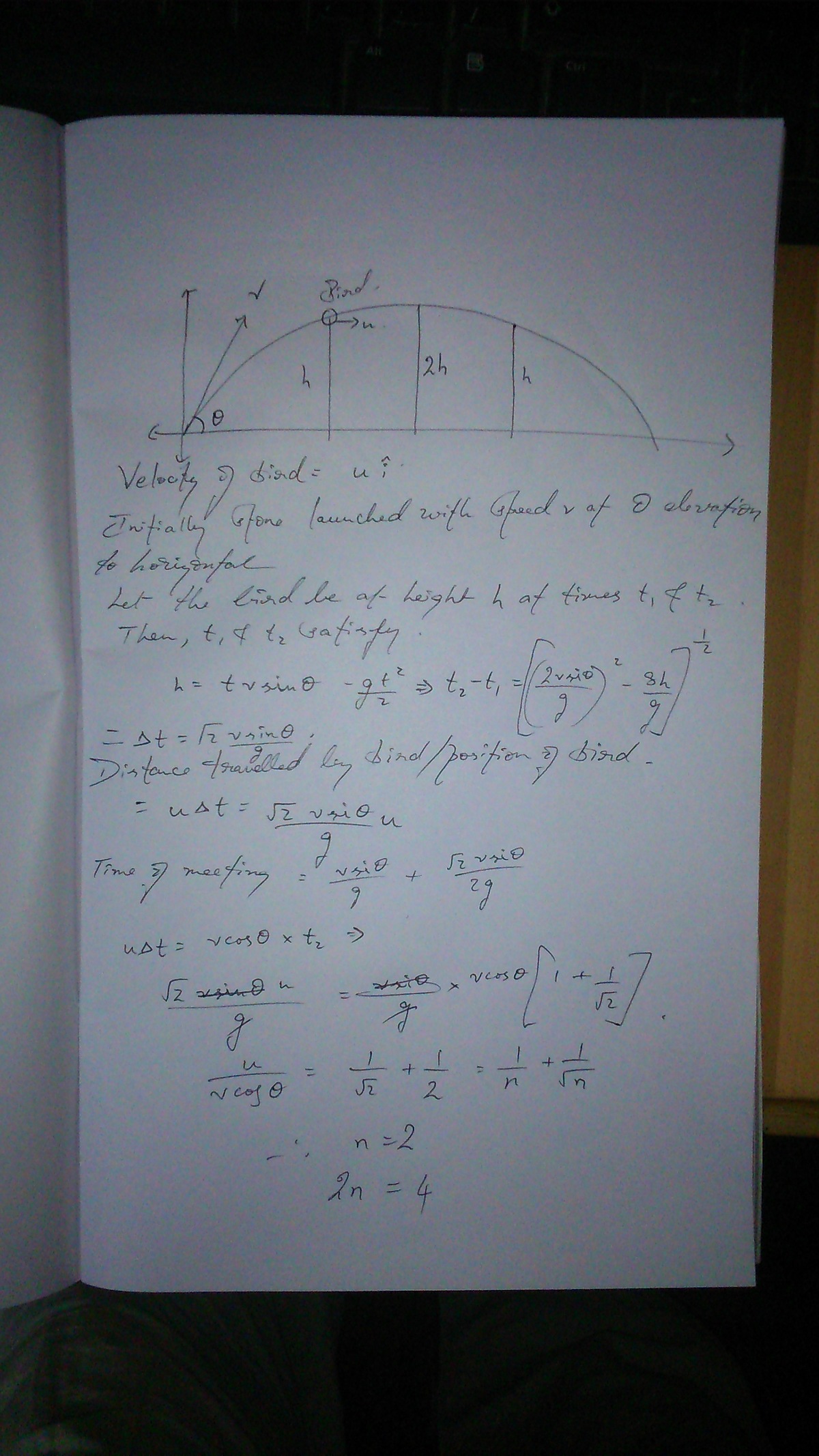One Bird With The Same Stone... Twice!
Nina throws a stone in such a way that it will hit a bird perched at the top of a tree on its way up. However, once the stone is thrown, the bird flies horizontally at constant velocity in the same plane as the path of the projectile, only to be struck by the stone on its way back down. If the stone's path reaches a maximum height of twice the height of the tree, then the ratio of horizontal velocity of stone to that of the bird is in the form n 1 + n 1 .
Find 2 n .
The answer is 4.
This section requires Javascript.
You are seeing this because something didn't load right. We suggest you, (a) try
refreshing the page, (b) enabling javascript if it is disabled on your browser and,
finally, (c)
loading the
non-javascript version of this page
. We're sorry about the hassle.
4 solutions
The thing is that unless the horizontal relative velocity is zero,the stone and bird cannot definitely meet..So ux/v is always 1 and let me prove it.. In birds frame of reference,the stone shall meet it twice only when it's velocity is wholly vertical,otherwise the trajectory would be a parabola and they wont meet..
@chirag shyamsundar That is exactly what i have reported but they have not answered yet.
so @ved sharda says for B to D bird takes (t+t') time & stone takes 2t' time & obviously
t+t'>2t'
It means stoned stopped at D & waited for bird to come & to be hit.
Update-Now question is edited all is well (23/01/16)
Great question!
Let us suppose the height of the tree to be
h
.
Then, the maximum height attained by the ball is
2
h
.
The premise of the question is that the ball is thrown with some initial velocity v . The bird starts to fly horizontally at the same instant with some velocity b . This implies it stays at the same height h from the ground. The ball goes to a height 2 h , starts to descend and then hits the bird.
- Firstly, lets find the initial vertical velocity v y of ball
Maximum height attained by the ball will be 2 g v y 2 , which should be equal to 2h. Hence, v y = 2 h g
- Second, we find the times at which the ball attains the height h .
Writing our equation for block's vertical motion yields
s y = u y t - 2 t 2 g .
The quadratic above gives two values of t, g 2 h g − 2 h g & g 2 h g + 2 h g .
Clearly, the former is the time when ball attains h height while going up and latter is the time for which it is at the same height h while descending down.
- Let's find the answer!
The bird flies for a duration of g 2 h g + 2 h g at velocity b .
This distance would be the same as the difference in the horizontal distances covered by the stone in between the two times i.e. ( g 2 h g + 2 h g − g 2 h g − 2 h g ) u x
Equate and solve to find b u x = 2 1 + 2 1
The thing is that unless the horizontal relative velocity is zero,the stone and bird cannot definitely meet..So ux/v is always 1 and let me prove it.. In birds frame of reference,the stone shall meet it twice only when it's velocity is wholly vertical,otherwise the trajectory would be a parabola and they wont meet..
Log in to reply
Where does the "g" goes in the last step Ux/b?
@Niranjan Khanderia He was referencing this solution. You were in the reports forum, which is different from the solution forum.
Same way!!!!

posted a pic of the solution as i found it cumbersome to type all those terms
Did the same
Great use of projectile. I have done it using the time taken by the stone to reach height H/2 secomd time is equal to time taken by bird to reach same position from the first position.
The thing is that unless the horizontal relative velocity is zero,the stone and bird cannot definitely meet..So ux/v is always 1 and let me prove it.. In birds frame of reference,the stone shall meet it twice only when it's velocity is wholly vertical,otherwise the trajectory would be a parabola and they wont meet..
Point A is point of projection of stone
Point B is top of the tree of height 'h'
Point C is maximum height of stone
D is point where stone hit the bird
E is point of landing of stone
Let time from A to C is t , similarly time from C to E is also t
Let time from B to C is t' , similarly time from C to D is also t'
At point C , H = 0.5g(t')² , 2H = 0.5gt²
By this t=√2t'
When stone reach at point D , time of bird from B to D is t+t'
Let speed of bird is V
V(t+t')=Ux(2t')
V(√2t'+t')=Ux(2t')
(√2+1)\2 = (Ux)/V
1/√2 + 1/2 = Ux/V
So n = 2 and 2n = 4